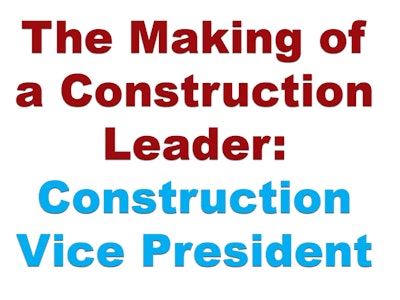
Wow, has the role of a vice president in a construction company evolved over the years. For many contractors the “VP” might have been a spouse, a son or daughter awaiting his or her chance to take the reins from their father, or even an important and older experienced field leader who took more of an “inside” job for the company. In some cases, the job title was strictly “ceremonial,” leaving the individual with a job title that sounded important but leaving the person’s primary job functions unchanged.
Not that there is anything wrong with any of those situations. Today, however, the role of construction vice president has expanded; it’s taken on more-specific responsibilities, demanding in the process an individual who is more skilled and “schooled” in ways to grow the company along with the president and/or owner.
Let’s look first to some of the functions that a vice president might tend to fulfill today. Then we’ll examine some preparation efforts that a contractor can take to make sure that their next VP is ready to make a tremendous contribution to the company.
Today’s construction vice president (“Veep”) tends to:
- Oversee a defined area of the company: operations, pre-construction, field superintendents, project management, business development, estimating, finance, human resources, and just about any combination of the above depending on the size of company.
- Represent the company at social/networking opportunities: Many contractors have realized the increased demand to be visible throughout their market area. Assigning the job title Vice President does tend to enlarge the importance of the owner’s “cabinet,” with each member representing the contractor at Chamber of Commerce meetings, local civic conferences and association functions. This effort alone can expand the community touch that has always been so important to the growing contractor desiring to grow their business.
- Think strategically with the owner to develop growth and business strategies, goals and action plans: This effort has become even more critical for the contractor to have at his or her disposal. I’ve witnessed a growing trend among contractors today to take serious their future growth opportunities and to implement a more formal strategic process. No matter the size of contractor, thinking strategically will place the contractor above and beyond the competition and engaging their VPs in the process can only strengthen the overall results.
- Work more intimately with local financial institutions: There once was a day when any contractor who had been in business for five or more years, and who had a solid and proven business, could walk in and borrow money for equipment or seasonal start-up expenses. Those days are mostly nowhere to be found. Therefore, the discipline of financial reporting, accuracy in the reporting, etc., all demand the best that a contractor can put forth. The Vice President can and often does support this effort, even taking part in meetings and negotiations with bankers and other financial professionals needed for the construction business.
- Keep their knowledge about industry trends, warnings and developments up-to-date: Vice Presidents must set the example to be educated and informed. This doesn’t require a college education, but there must be a firm resolve to know everything they can about their area of expertise and responsibility for their company and to be as well read on topics impacting their construction company.
- Provide honest and loyal support and insights: Let’s not overlook a critical strength of the VP for the contractor — listening ear when needed and a source for truth. The vice president should always be an individual who first, “has the boss’s back,” and second, “can tell the boss what he needs to hear, not what he wants to hear!” The contractor must have people close to them that they trust, can be honest with and who are not so impressed with the boss that he or she can spell things out very clearly, no matter if the news is good or bad. It is the vice president who must toe the line in living every value, expectation or goal the owner has created.
Now, let’s now turn our attention to the “making of a construction vice president.” Keep in mind the size of your construction company might dictate how much “making” is to be done before or after a promotion or new hire decision.
Start with the clear role description for the specific vice president
Before any promotion or hiring is executed take a big step back and seriously consider what is it exactly that the vice president’s role will be and what responsibilities will be embraced. Again, if you’re considering giving a long-term employee or an heir to your ownership the VP title, do them — and everyone else — a huge favor and spell out specifically what they will be overseeing, what they are in charge of leading and what level of authority they will have in the new role. You really can handicap your new vice president if you do not make clear what he or she is to do, whom they are to lead and what will be their relationship to the field, the office and the owner.
Have the VP candidate begin to read leadership-focused literature
This is easy to do, and there are a great number of leadership resources to pull from. The candidate, or brand new vice president, should also invest in reading John Maxwell, Tom Peters, Jack Welch, Tony Dungy and John Wooden to name just a few leadership “experts.” Reading a diverse group of leadership perspectives will provide your new vice president with the chance to consider the insights and wisdom from others. This effort alone is a great advantage especially for the vice president who might know only the one work culture that he has worked in for his adult life.
Hire a professional leadership “coach” for 12 to 18 months
Because I am so engaged with this very effort, I speak from more than 100 coaching experiences that new vice presidents have a lot of questions and will ask them more honestly with someone other than their own company president or owner.
A “coach” doesn’t have to be a construction expert but someone who is skilled in bringing out the best in others, who is not afraid to confront and to challenge, and who will provide clear direction on improvement opportunities. Having personally coached many vice presidents who did move on to the president position, I know that a great part of their professional, and personal development, was strengthened as a result of having someone to confess their insecurities to and to try out new ideas. It’s a win-win for everyone.
Provide greater financial education and understanding
If there is one area of executive development that I’ve observed for some 25 years that might be the biggest void in the education of a new VP it’s in the area of finance. Even if the VP is coming from an estimating, project management even superintendent role, understanding numbers for the job might still be a bit different than understanding quarterly earnings, cost reductions and how an increase or decrease in retained earnings might impact the company.
I’ve found it often positive for the company to arrange to have the VP attend some night classes or a series of weekend retreats where the focus is strictly on finances, financial reporting, investments, etc. As your new vice president grows in her financial understanding of her division or the company, the greater her confidence will positively impact other areas of her leadership.
Develop a greater strategic presence of mind
This can be a more difficult development to accomplish — a key reason is that so many construction leaders are great “tactical” decision makers. They are used to seeing a problem, solving the problem and moving on to the next problem. A strategic mindset takes a larger view of a developing situation and considers the long-term and short-term advantages, disadvantages, options and consequences. A strategic mindset recognizes that we need to “fix it now” but also works hard to consider the “how do we keep this from happening again” or “what can we do different to move beyond this point?”
So, what are the learning efforts involved with developing a more strategic presence of mind? Try a few of these:
- Introduce VP to strategic development literature
- Have your VP network with other companies who are engaged with strategic planning and development
- Conduct your own strategic retreat and have the VP participate
- Direct your VP’s professional coach to bring this strategic thinking to his or her efforts
Don’t give up on strategic development. Your entire senior leadership staff could probably benefit from the same education. Also, do not let the “gray” of strategic thinking fall to the wayside of purely black and white, “here and now,” tactical thinking.
Provide some “public speaking” and general communication development
Perhaps the largest change I’ve witnessed in the VP role in the past 10 to 20 years has been the amount of increased exposure to the public. From the largest of general contractors to the smallest of specialized trade contractor, the vice president is more visible at bank meetings, local association meetings, the guest speaker at conferences, and volunteer committee chairman for the Boys & Girls Club. Yet, public speaking remains one of the top five biggest fears felt by adults.
The only way you get anyone who is a little nervous to speak over the hump is to get them on their feet and to practice, practice, practice. If your new VP is shy or simply has not had any real communication or public speaking training or experience, get them in to a local communication coach, class or club ASAP!
Team building, team builder, team member
If your own construction senior leadership team really acts, thinks, eats, sleeps and works like a team you will have one of the best experiences that construction can provide. Every vice president should receive training in and be expected to perform in a team-like manner. This is much easier said than done.
I’ve received many “SOS” cries for help from contractors who hired a new VP only to find out that the “guy just isn’t fitting in” or “he’s not trying to be part of this team.” Yikes! Don’t wait to find out about whether or not your VP is or is not a “team guy.” Get him or her into some team training or coaching, and do it quickly. This improvement alone will also be greatly appreciated, and realized, by those whom they will be directly leading.
Focus on being a true “professional”
You can’t “put lipstick on a pig,” but you’re not hiring a pig to be your vice president. However, be committed to having vice presidents who you can be proud of to represent your company with others, including your own employees. The grooming effort can also be aided by a good professionally minded coach, but the effort should address how the individual views himself or herself, what his vision is for his leadership, being more aware of the image he has with others, how to work with different personalities, and a cadre of other professional making efforts. (I actually have a 14-chapter coaching book, Presenting a More Professional Image that you can purchase to coach your own developing leaders. See contact information below.)
We need smart construction leaders, true! But we also need professionally minded construction leaders who understand that people are not pieces of equipment that you can abuse and that “how” you work with others is just as important as the “what” you are doing for them.
We’ve covered a lot here, and there are perhaps at least another 15 topics that I could address such as:
- Stay updated on high-tech developments
- Stay updated on construction improvements
- Learn more about different behavior
- Customer satisfaction and retention methods
- Developing relationships with other contractors
- And on and on and on….
If you are preparing to promote an existing leader to the vice president position, have you prepared them along the lines of the suggestions I’ve provided here? It’s not too late!
If you are looking outside the company in search of a good vice president, are you inquiring as to what they have been exposed to in their own development? Don’t be shy; ask them!
No matter your situation, look today to move your next vice president to a greater level of responsibility and accountability. The effort will benefit both the new vice president and just about everyone else with whom they come into contact!
For more information about how to acquire Brad’s book, Presenting a More Professional Image, Relational Skills for the Construction Leader, call 682.500.2669.



















